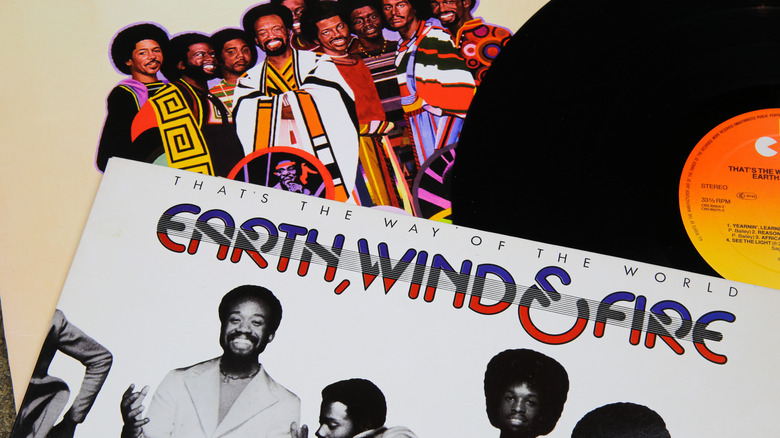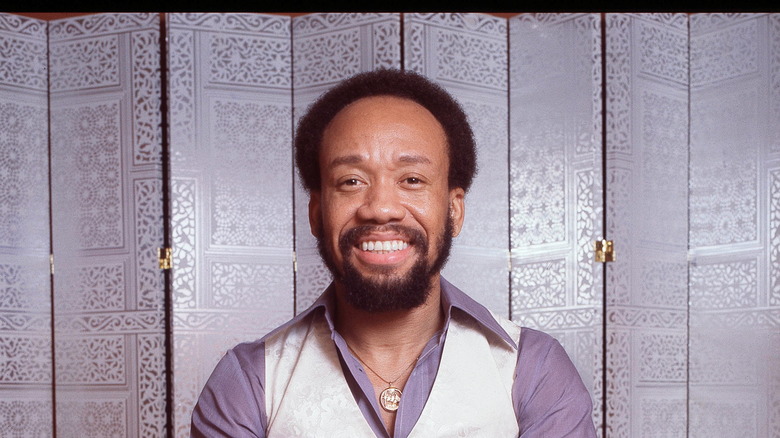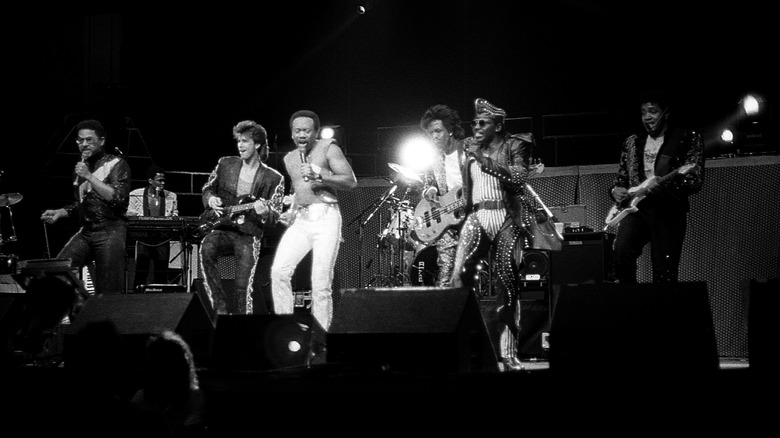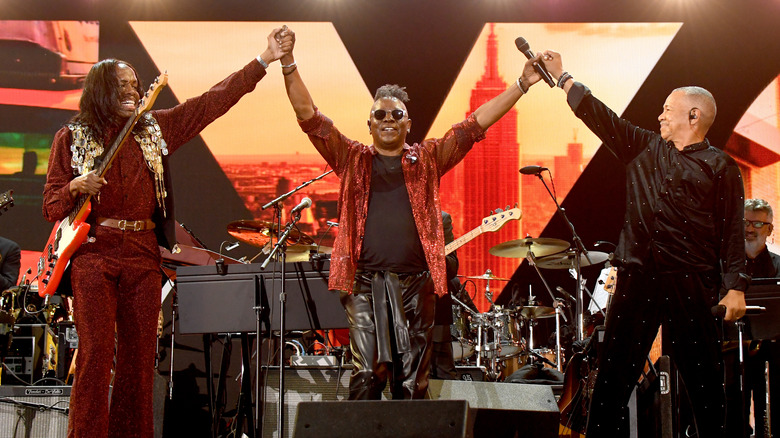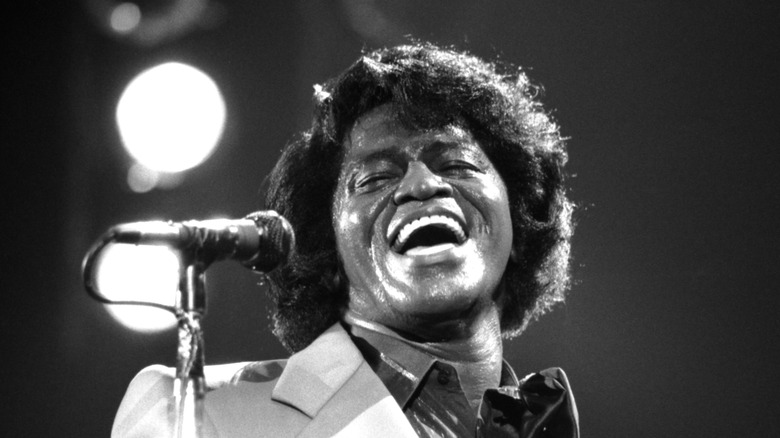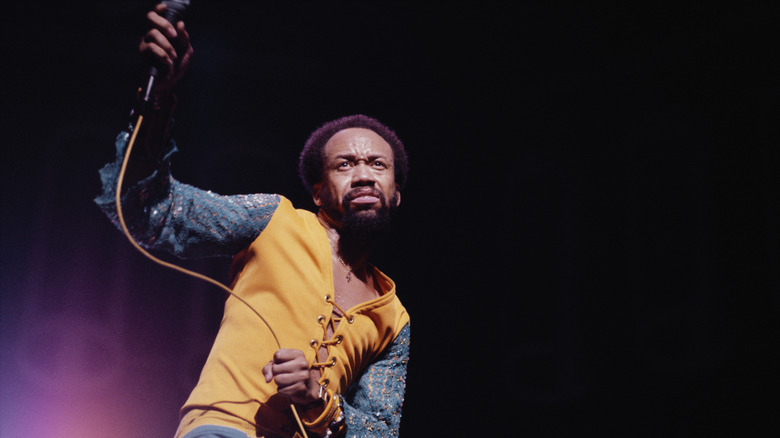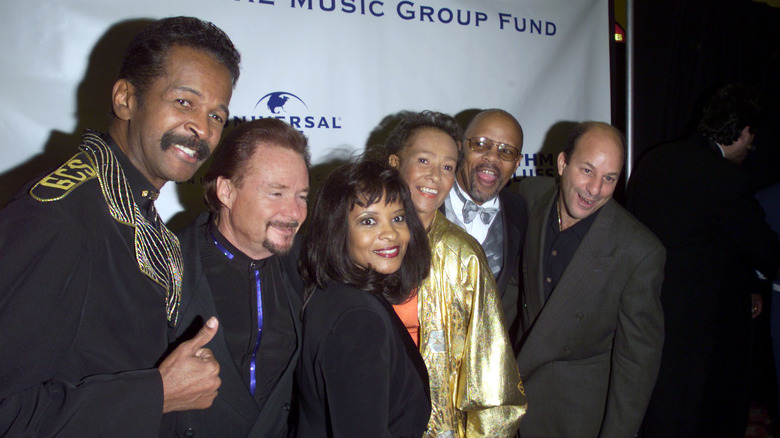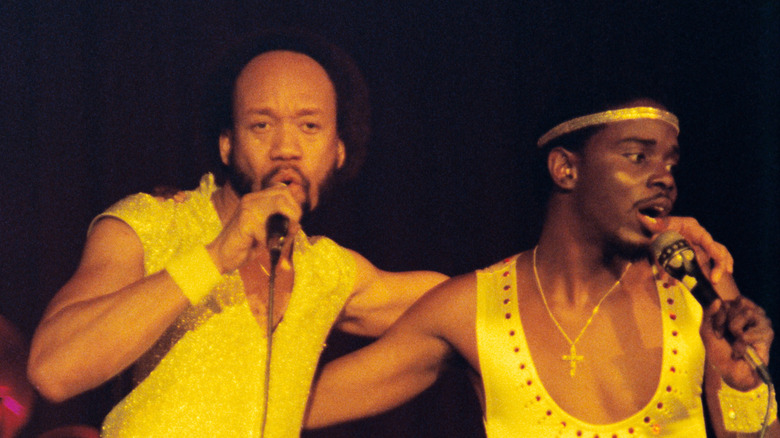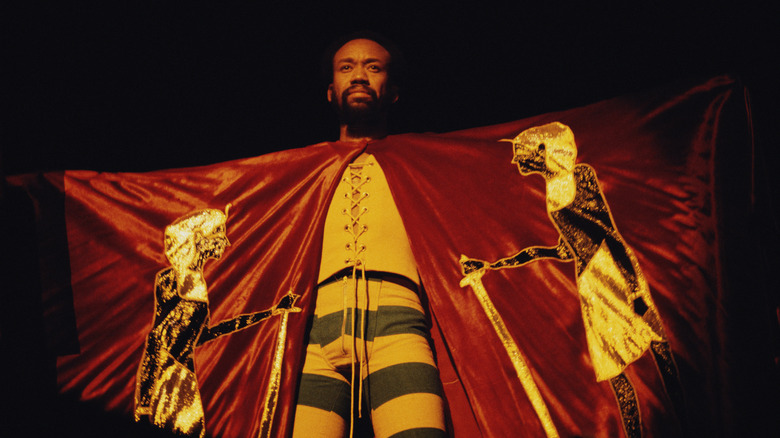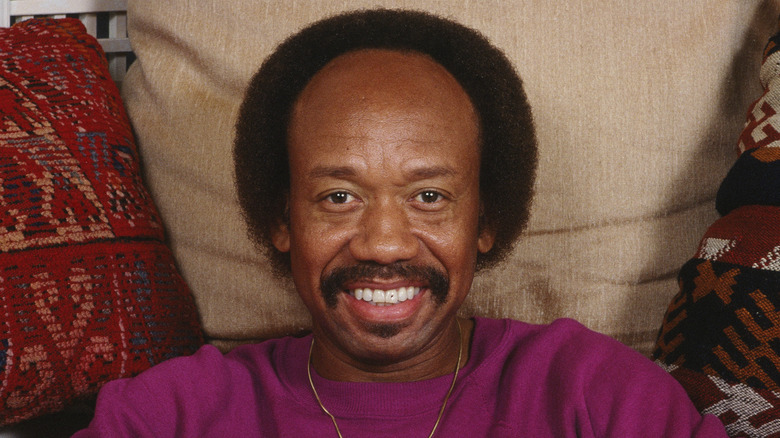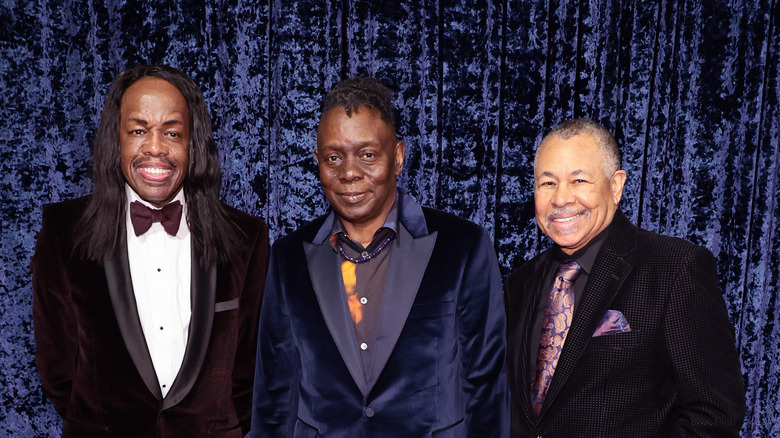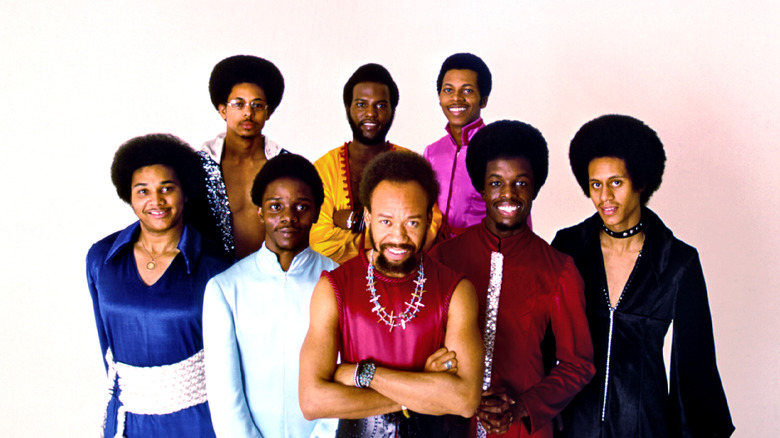Fascinating Facts And Stories About Earth, Wind & Fire
There are few bands as genre-defining and influential as Earth, Wind & Fire. Per the BBC documentary "The Story of Funk: One Nation Under a Groove," Maurice White's band brought funk to new heights, appealing to an unprecedented number of people and standing as a staple of African-American emancipation in the United States.
But just because Earth, Wind & Fire appealed to the masses, this doesn't make them any less of a complex band with a fascinating journey. As White commented (via the EWF official website): "We were coming out of a decade of experimentation, mind expansion and cosmic awareness." Indeed, there's a spiritual dimension to Earth, Wind & Fire, as well as a philosophy that transcends generations, race, creed, or country, for that matter.
And the journey is not over — as Songkick confirms, Earth, Wind & Fire are still touring, half a century after the band came to life, spreading the same inspiring messages and continuing the legacy of extremely talented, multi-faceted musicians. Here are some of the most fascinating facts and stories about Earth, Wind & Fire.
Maurice White was an acclaimed drummer before EWF
Everyone knows Maurice White as the founder and lead singer of Earth, Wind & Fire. But he was already an acclaimed musician when he started his band. As the band's official website states, White was born on December 19, 1941, in Memphis, Tennessee — a city with a culture that brought gospel, jazz, blues, rock, and R&B together. When he was only 6 years old, White began singing in the church choir, and by high school, his main interest had become percussion (he hadn't graduated yet when he played his first show with Booker T. Jones).
White then pursued a Bachelor's degree at the Chicago Conservatory of Music. Before long, he was a well-known session drummer for the Chess Records Label. It was there that he played with the likes of Etta James, Fontella Bass, Billy Stewart, Willie Dixon, and Sonny Stitt. In 1967, he joined the Ramsey Lewis trio, which White credits with teaching him the art of performance. According to All Music, it was also Lewis who introduced White to the kalimba, which he would use frequently on Earth, Wind & Fire songs. On Music Dictionary explains that the kalimba is a modern, Westernized version of the Zimbabwean mbira, which produces a delicate sound somewhere between a piano and percussion. The kalimba was a milestone for White's career — he was now well-versed in gospel, blues, jazz, and African sounds. He would bring them all together (and then some) in his band.
EWF is the tale of three brothers
As per the EWF official website, Maurice White founded his first band in 1969. It was called the Salty Peppers and it included himself on drums and vocals, and his two friends, Wade Flemons and Don Whitehead, on keyboards and vocals. The next year, White signed a contract with Warner Bros. and relocated to Los Angeles. That's when he decided two things. One: he would rename his band Earth, Wind & Fire, after the three signs in his astrological chart. Two: he would bring his little brother along.
Verdine White, who is 10 years Maurice's junior, remembers the moment on CBS: "All of a sudden he says, 'I'm bringing you to California.'" Verdine was only 19 at the time, but he was up for a musical adventure. (It wasn't a bad decision: He's still in the band today). But Verdine had a younger brother himself (both of them Maurice's half-brothers): Fred White. As Drum Magazine confirms, Fred was born in 1955, making him 14 years younger than Maurice. So when Maurice and Verdine left for LA and invited him along, he wasn't ready. However, he was already playing the drums with Donny Hathaway.
In 1974, Fred finally joined Earth, Wind & Fire — of course, by now the band already had Ralph Johnson on drums. But for Maurice, there were never enough members in his band. So Fred's addition only brought more depth to EWF's percussion and created the full sound we know today.
EWF is a spiritual quest for its members
What's perhaps most fascinating about Earth, Wind & Fire is that the band started with a quest: to spread the message of love and hope. The band's official website shares Maurice White's explanation: "I wanted our music to convey messages of universal love and harmony without force-feeding listeners' spiritual content." So EWF's signature songs full of positive vibes and hopeful lyrics are not a coincidence — they're a mission. White told Newsweek (via the EWF website): "We live in a negative society ... Most people can't see beauty and love. I see our music as medicine."
In 2020, the remaining original members of the band — Verdine White, Ralph Johnson, and Philip Bailey — told CBS that White also chose his band members carefully, so as to aptly reflect the EWF credo. Johnson said: "He wanted to deliver a message of hope and love and respect and raise the consciousness of the people. So each one of us was hand-picked, you know, for this mission." So Earth, Wind & Fire was not your usual 1970s sex, drugs, and rock 'n' roll experience — it was more spiritual than anything else.
James Brown was a huge inspiration
As Britannica reports, James Brown was known by many aliases, from "the Godfather of Soul" to "the Hardest-Working Man in Show Business." Brown grew up so poor, that he was once sent home from school for "insufficient clothes" — perhaps this explains his second alias. It was "the Godfather of Soul," however, that had a bigger influence on Earth, Wind & Fire. Through soul, Brown laid the grounds for early funk. As the BBC documentary "The Story of Funk: One Nation Under a Groove" explains, Brown started putting emphasis on the first beat in his songs — this might be a familiar rhythm for funk lovers, but back in the 1960s, it was ground-breaking. It was also a great influence on Maurice White.
Larry Dunn, Earth Wind & Fire's keyboardist, explains: "Every beat is there but there's always that accent on the one, which is very African ... That was that rhythm that would just stir the soul, as it were." If Brown was the Godfather of Soul and the proto-father of funk, so to say, then Maurice White was the musician who understood best how much funk relies on African beats, bringing them — as well as African instruments — into Earth, Wind & Fire. And this might not have happened without the revolutionary music of James Brown.
EWF brought together an unprecedented number of genres
Earth, Wind & Fire is as incredibly complex as it was light and approachable — rarely can a band be described both ways simultaneously. Many bands combined two or three genres: jazz, blues, rock, or soul. But EWF seemed to combine them all. Maurice White commented (via the EWF website): "I wanted to do something that hadn't been done before ... Although we were basically jazz musicians, we played soul, funk, gospel, blues, jazz, rock, and dance music ... which somehow ended up becoming pop." Black Past also lists R&B, disco, and Latin styles as genres White incorporated into the Earth, Wind & Fire sound.
Considering the unprecedented number of genres mixed in every song and the impressive number of band members, you might be excused for thinking Earth, Wind & Fire has a cryptic, perhaps even over-produced sound. But this isn't true at all — its approachability and popularity are easily demonstrated by its incredible list of achievements. As per Britannica, EWF had 11 consecutive gold albums (sales of 500,000 copies), eight of which also attained platinum (over 1,000,000 copies sold).
"The Story of Funk: One Nation Under a Groove" explains that Earth, Wind & Fire made their music universally appealing by bringing all of these styles together and polishing them to obtain a lighter, pop music sound. It's perhaps the stylistic complexity hidden under a pop mask that brought EWF to new funk heights, bringing together listeners that otherwise felt worlds apart.
Sly and the Family Stone inspired EWF through togetherness
There are more than a few parallels between Earth, Wind & Fire and Sly and the Family Stone. As Sly's official website states, Sly Stone also found his musical beginnings in gospel. Then, he learned a myriad of instruments and eventually brought them all together during high school, ending his musical education at Vallejo Junior College. But there is an even more relevant connection between the two bands.
When Sly and the Family Stone was created in 1967, it impressed audiences and critics with its togetherness — the way the band incorporated several members and gave each of them equal importance and creative freedom. Larry Grisham explains just that in "The Story of Funk: One Nation Under a Groove": "We were self-contained in that we were the band and we were the singers as well. And we would all contribute to the lead lines." Grisham added that the band members' different backgrounds and specializations brought together in an equal measure made Sly and the Family Stone a united group with a full, complex sound. Can you think of another band that did this?
Indeed, EWF also became known for its many band members, all contributing with different styles and techniques, a few years after Sly and the Family Stone became a sensation. All Music also associates the two bands through their ecclectism, spirituality, and positivity – it's easy to see how EWF took inspiration from their slightly older funk partners.
EWF were associated with Black emancipation
Earth, Wind & Fire did appeal to a tremendous amount of people, no matter their race, age, or gender. But as per the BBC Documentary "The Story of Funk: One Nation Under a Groove," EWF rose to prominence during the mid-to-late 1970s. During this time, the Black middle class in the United States was growing at a fast pace. Many African-Americans were thus moving from the south to white neighborhoods throughout the country, also adopting more lavish lifestyles and showing it through conspicuous fashion. This phenomenon became intertwined with Earth, Wind & Fire.
Musician Greg Tate explains: "The music is, in some ways, leading that charge of Black America ... being able to move out of the hood and into these areas with nicer homes, nicer schools, nicer lawns. So there's a sociological parallel." Earth, Wind & Fire thus became symbols of Black emancipation, sporting the same positive, confident attitude that so many African-Americans were adopting at the time. Interestingly, EWF was also the first funk band to be as popular in the Midlands as it was on the West and East Coasts. Whether this is because they appealed to people of all races and backgrounds or because the newly-emancipated African Americans were spreading their message everywhere they moved, we might never know. But the answer is most likely somewhere in the middle.
Magic was a big part of their shows
Today, it's no surprise that live shows have a strong visual element to them — just look at ABBA's 2022 Voyage tour. But when Earth, Wind & Fire brought magic tricks on stage during the 1970s, it was completely revolutionary. As shown in "The Story of Funk: One Nation Under a Groove," EWF's band members wore glamorous costumes, danced to a well-constructed choreography, and performed magic tricks while smoke, lights, and sparks decorated the stage.
Larry Dunn commented: "As well as having a well-honed and toned band musically, let's give the people a feast for their eyes as well as it is." Al McKay, who played the guitar for Earth, Wind & Fire, explained that the most prevalent theme in the band's shows was Ancient Egypt (this can be plainly seen in their costumes during the 1970s and 1980s). So many of the magic tricks performed on stage involved pyramids and pharaohs. McKay added: "People thought we could levitate. People thought we could ... do our hands and do things that were coming. They really thought we were magicians after a while."
EWF's official website lists floating pianos, spinning drum kits, and vanishing artists as some of the usual magic acts done live by the band. Interestingly enough, these shows were put on by Doug Henning and David Copperfield — the latter became one of the most successful magicians in history.
Maurice White was a producer and record label owner
Maurice White has always been a jack of all trades (combining gospel music, jazz, and blues ever since high school). But as per Earth, Wind & Fire's official website, during the late 1970s, White also started dabbling in record producing. He produced artist Deniece Williams' 1976 album, "This is Niecy." He also produced two albums for The Emotions: "Flowers" and "Rejoice." The latter also featured their number one hit "Best Of My Love." In 1979, Earth, Wind & Fire would go on to release their famous hit "Boogie Wonderland," featuring The Emotions. During Earth, Wind & Fire's short hiatus in the mid-1980s, White also produced albums by Neal Diamond, Barbra Streisand, and Jennifer Holliday.
White was associated with Columbia Records, producing "Rejoice" and "This is Niecy" under their label. But in 1978, as Discogs reports, White created his own record label, still in association with Columbia Records. It was called ARC, which stood for American Recording Company, and it produced Earth, Wind & Fire albums, as well as albums from artists like Ray Kennedy, Ren Woods, and Pockets.
There was a brief hiatus
Throughout the late 1970s and early 1980s, it seemed like Earth, Wind & Fire was on top of the world — according to the BBC documentary "The Story of Funk: One Nation Under a Groove," EWF had five top 10 albums in just a few years, and they filled huge stadiums month after month. But nothing lasts forever, and by 1983, the interest in EWF was slowly waning. This is when Maurice White decided to take a quick break from the band and pursue a solo career.
Just like White, many Earth, Wind & Fire members dabbled in solo albums between 1983 and 1987. White released his solo album titled simply "Maurice White" (via the EWF website). Philip Bailey, on the other hand, released several successful albums during the EWF hiatus, per Discogs. His debut album was titled "Continuation" and came out the same year EWF took a break. Next, Bailey released "Chinese Wall," which was praised by the Washington Post: "The spirit of Earth, Wind and Fire goes one step beyond on his second solo effort, guided masterfully by Phil Collins, who can't seem to make a misstep these days." Then, in 1986, Bailey released "Inside Out." It seemed like Bailey was on the path to solo greatness. But in 1987, White reunited all members of Earth, Wind & Fire. The reunion was met with great enthusiasm by listeners around the globe and, to this day, EWF (including Bailey) is united and active.
EWF were inducted into the Rock and Roll Hall of Fame by Lil' Kim
At the turn of the 21st century, musician Lil' Kim stepped on the Rock and Roll Hall of Fame ceremony stage and said: "There's music that you like and then there's music that you just plain old need ... Earth, Wind & Fire completely changed what soul music can be, breaking a lot of ground for so many of us who followed." Lil' Kim is a rapper above all else, but her speech was a hats-off to a band who, she recognized, influenced a myriad of bands afterward, no matter their genre or preferred beats.
While Maurice White gave a very short speech, joking that he was speechless, Philip Bailey made it all too clear that celebrating Earth, Wind & Fire means celebrating White himself: "You ... honor a man with vision and tenacity and courage, one who had a dream and tackled that dream and fought against every obstacle."
Earth, Wind & Fire were inducted into the Rock and Roll Hall of Fame in 2000, alongside Eric Clapton, Nat "King" Cole, and Billie Holiday, proving just how big of an influence EWF was in the musical world. And Lil' Kim's speech (and all-too-different musical journey) goes to show just that.
Maurice White passed away (but EWF continues his legacy)
Maurice White had a decades-long struggle with Parkinson's disease. As CBS reports, he had already been diagnosed for some time when he decided to stop touring with EWF in 1994. That was a crossroads moment for the rest of the band, as they had to work out whether they could continue without their founder. Ralph Jonshon remembers: "We had to make a decision: could we go on without Maurice? Would the audiences accept us without Maurice?"
As it turned out, they would. Earth, Wind & Fire continued to be a successful group after White's departure. In 2016, White died at his Los Angeles home, as the Guardian reports. But White never truly left Earth, Wind & Fire. Throughout its whole existence, the band continued to spread White's message of love, hope, and cosmical awareness.
Speaking to CBS in 2020, following their Kennedy Center Honors induction, Verdine White, Ralph Jonhson, and Philip Bailey confirmed EWF's music is still a vessel for White's original quest: "Kind of goes back to Maurice's original intent from day one — to render service to humanity ... he left it in our hands and he was proud of it."
